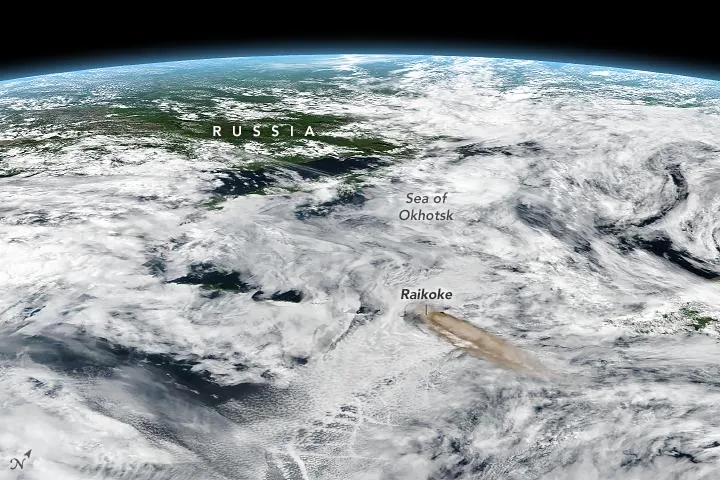Astronauts Capture Stunning Image of Volcano Erupting for the First Time in 95 Years
The ash plumes from Raikoke reach 42,700 feet
/https://tf-cmsv2-smithsonianmag-media.s3.amazonaws.com/filer/36/59/36596d9e-3838-4d75-8d20-14e4ea5dfc06/screen_shot_2019-06-27_at_15354_pm.png)
Raikoke, an uninhabited volcanic island in the northwest Pacific, last erupted in 1924. It then went silent for nearly 100 years, until, on June 22, Raikoke spewed forth a blast of ash and volcanic glass so powerful it could be seen from space. And fortunately, astronauts on board the International Space Station were there to capture the moment.
A dramatic photo released by NASA shows the volcano’s plume shooting up over the clouds. It forms a narrow column that spreads into what is known as the “umbrella region”—the area where the density of the plume and that of the surrounding atmosphere equalizes, causing the plume to stop rising. You can also see a ring of clouds around the column, possibly the result of water vapor condensation or the “interaction between magma and seawater,” says Simon Carn, a volcanologist at Michigan Tech. “Raikoke is a small island and flows likely entered the water,” says Carn.

The eruption, which was also documented by several satellites, consisted of at least nine explosions, six of which occurred within the first 25 minutes, according to a report by the Smithsonian Insitution's National Museum of Natural History’s Global Volcanism Program. The ash rose up to 42,700 feet, drifting to the east and northeast. Lightning was detected in the plumes, a phenomenon is known as a “dirty thunderstorm,” writes Matthew Cappucci of the Washington Post. The cause of volcanic lightning is not entirely clear, but scientists think it may result from charged particles originating from both “the material ejected from the volcano and through charge formation processes within ash clouds moving through the atmosphere,” according to Deanna Connors of EarthSky.
Raikoke is part of the Kuril Islands, an archipelago that stretches between Russia's Kamchatka Peninsula and Japan’s Hokkaido. Though no humans live on Raikoke, volcanologists were keeping a close watch on the latest eruption because it reached the stratosphere, which is where many planes fly. The ash flung up by volcanoes contains fragments of rock and glass, posing a serious hazard to aircraft. The Tokyo and Anchorage Volcanic Ash Advisory Centers have thus been tracking the plume and issuing notices to aviators, according to NASA.
Stratospheric eruptions can also have a greater impact on climate than those that stay lower down in the troposphere. Some gases spewed out by volcanoes, like carbon dioxide, can cause global warming; others, like sulfur dioxide, may promote global cooling. NASA reports that when Raikoke erupted, a concentrated plume of sulfur dioxide separated from the plume and began drifting across the North Pacific. Satellite sensors have been tracking the movement of Raikoke’s volcanic gases.
On June 25, Raikoke was still producing some ash plumes, these rising to a relatively modest height of around 6, 500 feet. But thanks to the ISS astronauts, the stunning moments of the volcano’s initial eruptions were preserved for all to see.